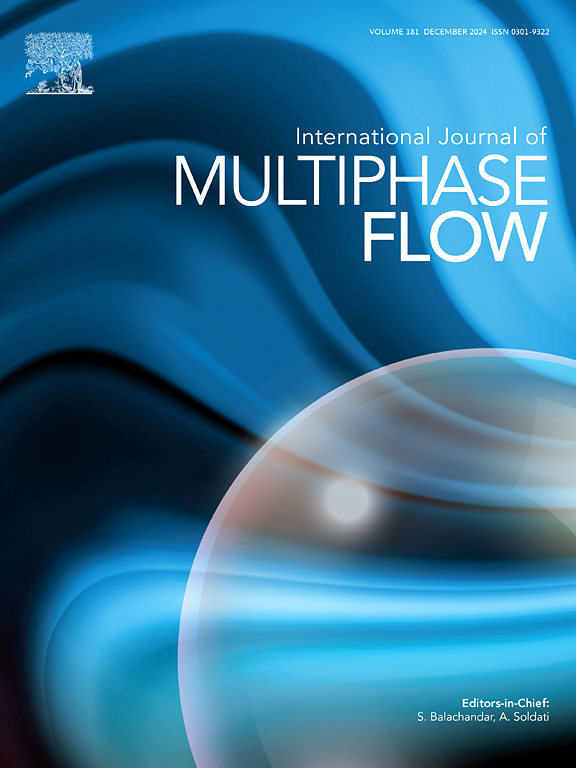应用于气液水平管流的机器学习不确定性框架
IF 3.6
2区 工程技术
Q1 MECHANICS
International Journal of Multiphase Flow
Pub Date : 2025-02-19
DOI:10.1016/j.ijmultiphaseflow.2025.105184
引用次数: 0
摘要
精确的多相管流建模(如压降和体积分数的预测)对许多学科和行业都很重要。利用实验室数据或模拟器输出和机器学习技术开发管道多相流模型是可能的,但由于其黑箱性质和欠佳的泛化性能,它们的应用受到限制。通过“教模型知道它们知道什么”,并将预测不确定性与平均值一起输出,可以提高这些模型的有效性。通过给出随机预测,该模型可以告知用户其预测的不确定性,方便用户做出明智的决策。在这项工作中,我们评估了3种机器学习框架和3种参数化策略,用于开发随机数据驱动的气液管道流量(压力和含率)模型。这是为了最终确定哪种机器学习框架和参数化策略产生最适合数据集的随机模型,捕获其相关的不确定性,以及外推场景中预测的不确定性在哪里显著增长,从而使模型无用。为此,使用商业多相流模拟器创建了稳态两相水平流合成数据集,以训练和验证三种深度学习框架:深度集成、超深度集成和蒙特卡罗dropout。还评估了使用不同组的输入特征来预测压力梯度和滞留率的性能效果,并基于域内(验证)和域外(外推)情况评估了性能指标,后者由缩放场景(更大的直径)组成。结果表明,三种框架均能准确预测平均值。然而,深度集合在预测不确定性范围方面优于其他集合。此外,结果还显示了不同维度和无维度输入对模型训练和预测的特征重要性。本文章由计算机程序翻译,如有差异,请以英文原文为准。

Machine learning uncertainty framework applied to gas-liquid horizontal pipe flow
Accurate multiphase pipe flow modeling (e.g. prediction of pressure drop and volume fraction) is important for several disciplines and industries. It is possible to develop pipe multiphase flow models using laboratory data or simulator output and machine learning techniques but their application is limited due to their black-box nature and subpar generalization performance. The effectiveness of these models can be improved by “teaching the models to know what they know” and outputting the prediction uncertainty together with a mean value. By giving a stochastic prediction, the model can inform the user about the uncertainty of its prediction, facilitating informed decision-making. In this work, we evaluate 3 machine learning frameworks and 3 parametrization strategies for the development of a stochastic data-driven gas-liquid pipe flow (pressure and holdup) model. This to ultimately determine which machine learning framework and parametrization strategy produces stochastic models that best fit the data set, capture its associated uncertainty and where the predicted uncertainty grows considerably in extrapolation scenarios, rendering the model useless. For this purpose, a steady-state two-phase horizontal flow synthetic dataset was created using a commercial multiphase flow simulator to train and validate three deep learning frameworks: deep ensembles, hyper-deep ensembles, and Monte Carlo dropout. The effect of the performance using different groups of input features to predict the pressure gradient and holdup is also evaluated, and the performance metrics are assessed based on in-domain (validation) and out-of-domain (extrapolation) cases, the latter consisting of a scale-up scenario (bigger diameter). Results indicate that all three frameworks accurately predicted the mean values. However, deep ensembles outperformed the other in predicting the uncertainty range. Additionally, the results show the feature importance of different dimensional and dimensionless inputs for the model training and prediction.
求助全文
通过发布文献求助,成功后即可免费获取论文全文。
去求助
来源期刊
CiteScore
7.30
自引率
10.50%
发文量
244
审稿时长
4 months
期刊介绍:
The International Journal of Multiphase Flow publishes analytical, numerical and experimental articles of lasting interest. The scope of the journal includes all aspects of mass, momentum and energy exchange phenomena among different phases such as occur in disperse flows, gas–liquid and liquid–liquid flows, flows in porous media, boiling, granular flows and others.
The journal publishes full papers, brief communications and conference announcements.

 求助内容:
求助内容: 应助结果提醒方式:
应助结果提醒方式:


